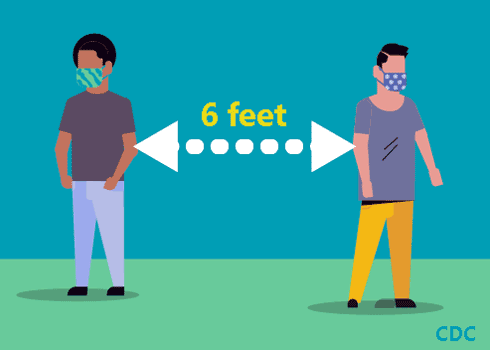Limiting face-to-face contact with others is the best way to reduce the spread of coronavirus disease 2019 (COVID-19).
What is social distancing?
Social distancing, also called “physical distancing,” means keeping space between yourself and other people outside of your home. To practice social or physical distancing:
- Stay at least 6 feet (about 2 arms’ length) from other people
- Do not gather in groups
- Stay out of crowded places and avoid mass gatherings
In addition to everyday steps to prevent COVID-19, keeping space between you and others is one of the best tools we have to avoid being exposed to this virus and slowing its spread locally and across the country and world.
Limit close contact with others outside your household in indoor and outdoor spaces. Since people can spread the virus before they know they are sick, it is important to stay away from others when possible, even if you—or they—have no symptoms. Social distancing is especially important for people who are at higher risk for severe illness from COVID-19.
Many people have personal circumstances or situations that present challenges with practicing social distancing to prevent the spread of COVID-19. Please see the following guidance for additional recommendations and considerations for:
- Households Living in Close Quarters: How to Protect Those Who Are Most Vulnerable
- Living in Shared Housing
- People with Disabilities
- People Experiencing Homelessness
Why practice social distancing?
COVID-19 spreads mainly among people who are in close contact (within about 6 feet) for a prolonged period. Spread happens when an infected person coughs, sneezes, or talks, and droplets from their mouth or nose are launched into the air and land in the mouths or noses of people nearby. The droplets can also be inhaled into the lungs. Recent studies indicate that people who are infected but do not have symptoms likely also play a role in the spread of COVID-19.
It may be possible that a person can get COVID-19 by touching a surface or object that has the virus on it and then touching their own mouth, nose, or eyes. However, this is not thought to be the main way the virus spreads. COVID-19 can live for hours or days on a surface, depending on factors such as sunlight, humidity, and the type of surface. Social distancing helps limit opportunities to come in contact with contaminated surfaces and infected people outside the home.
Although the risk of severe illness may be different for everyone, anyone can get and spread COVID-19. Everyone has a role to play in slowing the spread and protecting themselves, their family, and their community.
Tips for social distancing
- Follow guidance from authorities where you live.
- If you need to shop for food or medicine at the grocery store or pharmacy, stay at least 6 feet away from others. Also consider other options:
- Use mail-order for medications, if possible.
- Consider a grocery delivery service.
- Cover your mouth and nose with a cloth face covering when around others, including when you have to go out in public, for example to the grocery store.
- Cloth face coverings should NOT be placed on children under age 2, anyone who has trouble breathing, or is unconscious, incapacitated, or otherwise unable to remove the mask without assistance.
- Keep at least 6 feet between yourself and others, even when you wear a face covering.
- Avoid gatherings of any size outside your household, such as a friend’s house, parks, restaurants, shops, or any other place. This advice applies to people of any age, including teens and younger adults. Children should not have in-person playdates while school is out. To help maintain social connections while social distancing, learn tips to keep children healthy while school’s out.
- Avoid using any kind of public transportation, ridesharing, or taxis, if possible.
- If you are a student or parent, talk to your school about options for digital/distance learning.
Stay connected while staying away. It is very important to stay in touch with friends and family that don’t live in your home. Call, video chat, or stay connected using social media. Everyone reacts differently to stressful situations and having to socially distance yourself from someone you love can be difficult. Read tips for stress and coping.

